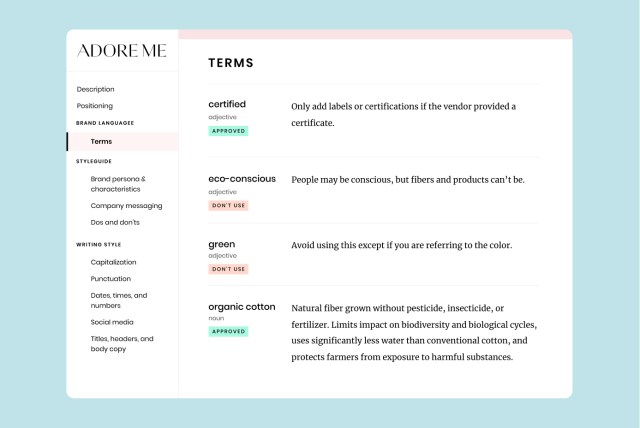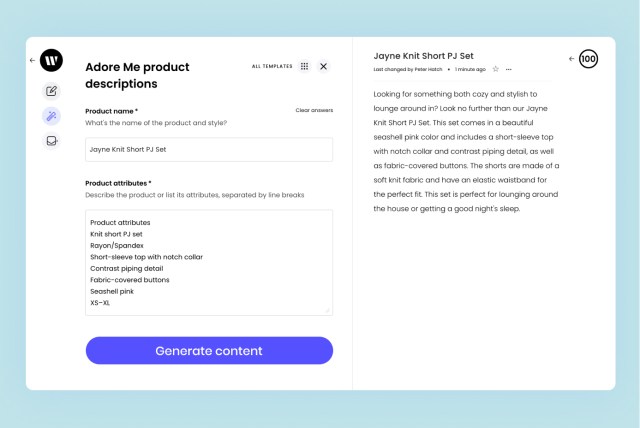- story – 10 min read
- AUDIO – 23 min
Seeing is believing:
Ranjan Roy on Adore Me’s
strategic shift to AI

launched in 2021
month saved with Writer
Listen to Adore Me’s story or read the (edited) transcript below
WRITER is the full-stack generative AI platform for enterprises. We make it easy for organizations to adopt AI apps and workflows that deliver quantifiable ROI quickly.
WRITER helps organizations build highly-customized AI apps that compress entire business processes, support complex use cases, and infuse work with company intelligence. Our enterprise-grade platform can be deployed flexibly, keeps your data private, and adheres to global privacy laws and security standards. Leading enterprises choose WRITER, including Vanguard, Intuit, Accenture, and Kenvue.
Ranjan Roy is the SVP of Strategy at Adore Me. Read the story of how Ranjan accelerated Adore Me’s content production process by automating away repetitive writing tasks and aligning team members on sustainability language.
The Adore Me team uses WRITER to:
- Write product descriptions automatically, saving them thousands of hours a year
- Automatically enforce environmental, social, and governance (ESG) compliance
- Free up resources so team members can work on more high-impact projects
How did your own personal journey into using AI for content generation start?
For me, AI and content generation has actually been a longtime interest. In a past life, I ran a startup related to news content personalization. We were looking a lot at summarization as a technology. This is in the old days of 2014, 2015 — long before GPT-3 and every other new technology that’s really pushed things to the next level. So I’ve watched this space closely, but things were never really prime time-ready.
GPT-3, at a mass market level, has really popularized the idea that this kind of writing and content generation is possible. So already we were exploring these types of tools, anything with the word “NLG,” Googling “What are the latest tools?” We were already definitely trying to be ahead of the curve, because we think it’s going to become part of every company — especially every retailer.
What were the content challenges that led you to explore AI content generation?
Obviously the promise is, “AI-generated content should help you with the boring, structured stuff.” An individual sitting there who wants to work on much more creative endeavors should have the time to do that, and not have to worry about the really boring stuff that they’ve done repetitively.
As a fast-growing startup, the one advantage we have is there’s always lots and lots of work to be done, and lots of opportunity, especially around doing more creative things. And for us, we see that everyone wants to be working on the next big project, the next big campaign. So to be able to have a lot of your day-to-day, more monotonous work taken care of — or at least made much, much faster — everyone instantly sees the actual promise available then.

Why did you choose WRITER?
One-size-fits-all companies, that try to be B2C and B2B, fun experimental side projects, but also that somehow will cater to a Fortune 500 company — I don’t think those tools will really work and actually deliver on the promises that they try to.
I think the first thing that attracted us to Writer in this space was seeing how well-tailored it was to actually solving real business problems for us. In building an actual tool that a business can use — that an organization can use to solve real problems it’s having, or try to make processes better and more efficient — I think we definitely had faith that Writer was much better-positioned for that.
What was the a-ha moment for you and your writers when you started using WRITER?
For me, the light bulb moment: press releases are one of the most painful things to be involved in the writing of, because they’re the definition of completely highly structured text. You’re not writing for a human, essentially. You’re writing for the crawlers. You’re writing for machines, not the actual pitch in itself. It’s just such a highly structured way of writing.
So every press release, we start with, “What are the 8-10 key bullet points we want to get across?” So Writer created an AI app around press releases for us, fed in the eight bullet points. What I will never forget is: we’re sitting around, reviewing it, trying to see how real it is. “Does this feel like it can pass our own Turing test?” “Could we even upload it directly to PR Newswire, and just move on?”
And a quote appears in the middle from our CEO: “The CEO of Adore Me says, ‘They’re very excited about this partnership.’” We look back — we had not named our CEO in the inputs to Writer, asked for a quote, done anything related to this. Anywhere in the bullet points, they’re purely factual, related to the partnership of us and the partner we were announcing.
And that was the moment it clicked. It was a moment that showed us, “This could make our life easier, because everyone hates writing press releases.”
“The first thing that attracted us to WRITER was seeing how well-tailored it was to solving real business problems for us.”

Ranjan Roy
SVP of Strategy, Adore Me
How have you all implemented WRITER so far?
It’s going very well. What started with simply trying to have a writing tool has turned into something at a much deeper level. In the past, a writing assistant tool simply checked your grammar and spelling. Now we’re able to cross-check any writing that’s being done against our voice, against our style guide. In the past, the copywriters were the holders of the style guide. Now everyone feels much more comfortable — whatever they’re doing, whatever they’re writing.
Sustainability has become much more of a focus at Adore Me, in the same way that it has at many other companies. Adore Me, as a company, is probably a bit more conservative and strict around compliance, around the terms we can use. We have a head of ESG compliance who comes down on you hard if you use terms in an overly aggressive marketing manner. So we built an entire style guide, specific to sustainability language, that we were able to incorporate into Writer.
It makes our lives so much easier, because we don’t use the word “green” in any of our marketing copy. We don’t use the word “eco-conscious” in any of our marketing copy, because our head of compliance said, “‘Eco’ can’t actually be ‘conscious’ in the same way a human can, a fiber can’t.” This has made it so much easier for every single writer involved in anything around sustainability. Greenwashing is at the top of the news conversation right now, so to have some easy way to have an already-vetted set of terms there at the ready has been incredible.

What is the competitive imperative behind the sustainability style guide?
ESG is a strategic push for us, the reason the style guide is even more relevant. We are actually very proud that our average customer is not the type of customer that shops specifically for sustainable fashion. We’re a very proudly mass-market brand. Our customers are spread out throughout the entire United States. So marketing towards them using standard language that companies typically use around sustainability isn’t good enough, or it won’t work because that’s not what they’re looking for.
So for us, it was trying to find this balance between communicating what is better about specific materials, fibers, and processes, but doing it in a way that’s not talking down to a customer, that’s still very accessible, so it doesn’t feel like this intimidating thing — versus a lot of brands that really try to push toward making sustainability the central selling point for all their products.
What was it like to roll out your WRITER style guide?
Having any kind of assistant that can very clearly and easily lay out style guide elements as you’re in the flow of writing makes your life easier. We’re a Google Workspace company; we use Docs: so being able to have everything very easily integrated for professional writers is very important. But I would also say, extending beyond the copywriting team, into our UX team, to other people writing on a day to day basis — Writer easily integrated into existing workflows, and that was the key, because trying to get people to adapt an entirely new way of working is always going to be more difficult.
“An individual who wants to work on more creative endeavors should have the time to do that, and not have to worry about the really boring stuff.”

Ranjan Roy
SVP of Strategy, Adore Me
How did you figure out which content tasks to automate with WRITER?
The way we approach any task now, with AI content generation in mind, is asking the questions: “How structured is the writing, and the data that’s underlying each individual output?” and “How repetitive and boring is this for the writer themselves? Do they want to express themselves in every output?”
So clearly: Google search ads fit very well into this; Facebook ad copy becomes a little more complicated, because usually it’s referencing an image; but press releases; highly structured product descriptions. Also, “Do we have past examples of this type of output?” so we can use that to work with the Writer team to train the model. It really is starting with that question, “How structured is this specific type of output?”
When there’s high revenue attached to a certain type of output, especially once you get into performance marketing, that initial willingness to start testing this is an uphill climb. But again, the beauty is, there’s direct numbers output on the other side — so very quickly you can see that the performance is consistent. Once you see that, it makes all this decision-making and editorial process-building a lot easier.
What have you all seen on the performance side for content generated with WRITER?
For us it always is, “Is it performing good enough relative to content generated by the team?” as a starting point. As long as it’s close enough — or ideally, equal — it should pass the test, and we should build processes around it. You start factoring in the amount of time saved, the money saved, and the residual value for your employees working on more inspiring projects.
For product descriptions, it was a very straightforward test. We are an e-commerce company and conversion rate is everything, so we ran a test and conversion rate was unaffected.

Have there been time savings or other process improvements?
Once the output is essentially unaffected, especially around things like conversion rate, it becomes about development time, and lessening that as much as possible. Around certain things like product descriptions, we’re saving 30 to 40 hours a month. In other areas we’re already cutting down time by 20, 40, 50%, even where a person is still very involved in checking, validating, and tweaking where needed.
At every level it’s freeing up resources: that, for us, is the key metric that we’re watching. As a startup, time and resources are everything — so the ability to move people into bigger, more high-impact and creative things really makes a difference, and gives us a competitive advantage.
“As a startup, time and resources are everything — so the ability to move people into bigger, more high-impact and creative things really makes a difference, and gives us a competitive advantage.”

Ranjan Roy
SVP of Strategy, Adore Me
What was the reaction to generated content that was so eerily similar to your voice? Was there hesitation?
Especially for tools like AI content generation, there still is, in 2022, a bit of pushback or hesitance about, “What does this mean for me? For my job, for humanity as a whole?”
With a tool like Writer, our brand guide and style guide is injected into the entire system and is already reflected in the way Writer works and the suggestions that are made [to what people write]. It really made everyone — especially outside of the content creation side of the company — feel like at all times you have someone who is perfectly trained in the voice, perfectly trained in the style guide.
You have a sidekick, an assistant, that is there to help you in any kind of communication you can make. So when you try to start extending this beyond the core copywriting content creation side of the organization, that’s the kind of thing where people really, really see value.
What has WRITER enabled your team to spend more time doing?
Writer is the dream around automation that everyone’s been promising, that is not necessarily realized in every part of society and technology: the idea that if you can automate away the boring stuff, the repetitive stuff, then it allows you to work on more creative efforts. Even on our team with copywriters, them moving on to spend more time on the big campaign stuff.
As a startup, we handle a lot of things in-house, including doing a lot of our campaigns in-house. It’s fun: coming up with crazy ideas, going on shoots, working directly with the models, coming up with the bigger ideas around the campaign — not just the copy. Having to spend less time putting out one line after another, one paragraph after another, opens up exactly those kinds of opportunities.

What’s next for you in terms of content automation at Adore Me?
One thing we’ve been doing more of is starting a thought process with Writer, starting to experiment more about how we can use this to become more creative ourselves. We’ve talked a lot about how anything structured with an output should be able to be automated in some way — even if not fully automated, a person should be able to sit there and be handed a bunch of different potential options, and then from that, choose to tweak slightly.
For bigger ideas and bigger types of business communications, using this as a starting point presents this interesting direction for this technology to go. Because to me that actually makes people more creative. It’s not even working on something separately and being more creative there, it’s having ideas you may never have thought of being generated.
What advice do you have for other leaders who are trying to bring more automation into their content practices?
What are the things that people complain about, that are repetitive to do? Someone trying to come up with something creative on a repeated basis is almost, by definition, perfect training data.
Everyone wants to communicate better. There’s so many people across your organization that have so many small things [to write], especially in a world of hybrid work where words carry so much more importance and are used in so many more contexts. Improving the way we communicate about business is becoming more important. Leaders looking to implement tools like Writer across their businesses — really recognizing that and reflecting on that — can push these kinds of efforts faster.